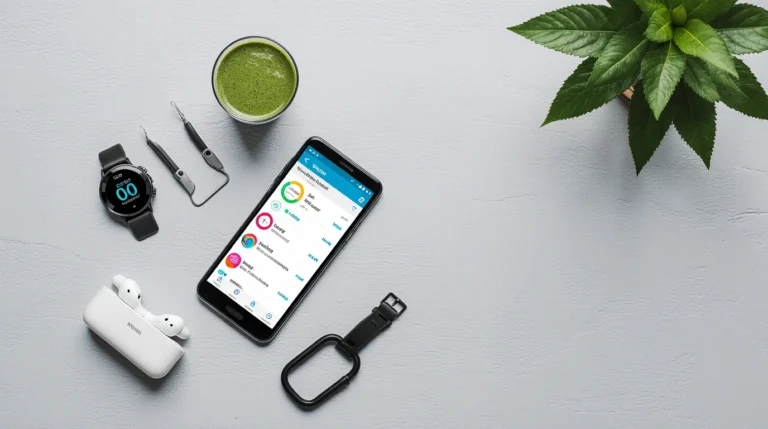What is HRV? The Ultimate Beginner’s Guide for 2025
So, What is HRV and Why Does It Matter?
If you own a modern smartwatch or fitness tracker, you’ve probably seen it: a metric called “HRV” tucked away in your health dashboard. While metrics like steps and heart rate are easy to understand, HRV remains a mystery to most. Yet, this single data point may be the most powerful indicator of your body’s resilience, stress levels, and overall recovery. So, what is HRV? Consider this your definitive guide to understanding this crucial metric and learning how to leverage it for better health. This concept is a cornerstone of our The Ultimate Guide to AI for Wellness.
Why a High HRV is Good: A Simple Look at Your Nervous System

To truly understand what is HRV, we first need to clear up a common misconception. HRV does not stand for Heart Rate. It stands for Heart Rate Variability—the measure of the variation in time between each of your heartbeats.
You might assume a healthy heart beats like a metronome—steady and regular. In reality, a healthy heart is constantly adapting. This adaptability is a sign of a resilient, well-rested nervous system that’s ready to handle whatever you throw at it.
The “Gas Pedal” and the “Brake Pedal”
The best way to understand this is to think about your autonomic nervous system as having two main branches, as explained by medical experts at institutions like the Cleveland Clinic:
- The Sympathetic Nervous System: Your Body’s “Action” System: This system prepares your body to react to demanding situations. It activates during moments of stress, exercise, or excitement, elevating your heart rate and getting you ready for intense physical exertion.
- The Parasympathetic Nervous System (The “Brake Pedal”): This is your “rest-and-digest” response. It’s dominant when you’re relaxed, aiding in digestion, recovery, and calming the body down.
A high HRV indicates a good balance between these two systems. It means your body is highly responsive and can easily switch gears—pressing the brake to relax after a stressful event or hitting the gas when needed. A low HRV, on the other hand, suggests that one system (usually the “gas pedal”) is stuck in the “on” position, a common sign of chronic stress, illness, or overtraining.
What a “Good HRV Score” Really Means
HRV is measured in milliseconds (ms) and is highly personal. There is no single “good” number, as it varies dramatically with age, gender, genetics, and lifestyle. A good HRV score for you is a score that is stable or increasing over time relative to your own baseline. A sudden, significant drop in your personal average is the key insight your tracker provides, signaling that your body is under increased strain.
5 Key Factors That Influence Your HRV Score
Now that you know what is HRV, it’s crucial to understand the daily factors that can influence your score. Your HRV is a sensitive metric that reflects your overall lifestyle. Here are the biggest factors that can impact it.
1. Mental & Emotional Stress:
A stressful day at work or emotional turmoil will activate your “fight-or-flight” system, causing your HRV to drop. Learning to manage stress is therefore crucial, and techniques like the ones in our guide on 5 Powerful AI Prompts for Immediate Stress Relief can be a great starting point.
2. Sleep Quality:
Your body does most of its recovery work during sleep, particularly during the deep sleep stage. A night of poor or insufficient sleep is one of the most common causes of a low HRV score the next morning.
3. Exercise and Training Load:
Intense exercise is a form of physical stress that will cause a temporary drop in your HRV, which is a normal response. Following your recovery period, your HRV is expected to rebound, frequently settling at a new, higher baseline as your body becomes more resilient. However, if your HRV remains suppressed for several consecutive days, it’s a powerful indicator that you are overtraining and require more rest.
4. Nutrition and Hydration:
Large, processed meals and alcohol can put significant stress on your system, often leading to a sharp drop in your overnight HRV. Staying well-hydrated and eating nutrient-dense foods generally supports a healthy HRV.
5. Illness and Alcohol:
A significant and sudden drop in HRV is often one of the first signs that your body is fighting off an illness, even before you feel symptoms. Alcohol consumption, even in moderate amounts, has also been shown to have a dramatic negative effect on HRV scores.
How to Reliably Measure Your Heart Rate Variability
After understanding what is HRV, the next logical question is how to measure it reliably.
To get meaningful data, you need consistent and accurate measurements. While ECGs in a clinical setting are the gold standard, modern consumer wearables have become remarkably effective for tracking trends. Devices like those featured in our Oura Ring vs Whoop comparison use advanced optical sensors to take nightly readings while you sleep. This is the most reliable method for consumer tracking because it measures your HRV in a controlled state, free from the confounding variables of daily life.
5 Practical Steps on How to Improve HRV
The great thing about tracking your HRV is that you can actively improve it. Here are five practical steps to do so. The good news is that you can actively influence your HRV. Here are five practical, science-backed strategies.
1. Consistent Sleep Schedule:
Your body thrives on consistency. Maintaining a consistent sleep schedule—by heading to bed and rising at similar times daily, weekends included—is crucial for stabilizing your circadian rhythm and reinforcing your parasympathetic (“rest-and-digest”) nervous system. For a deeper dive on this topic, see our guide to unlocking better sleep with AI.
2. Controlled Breathing Exercises:
Slow controlled breathing is the fastest way to manually activate your “brake pedal.” Techniques like box breathing (inhale for 4 seconds, hold for 4, exhale for 4, hold for 4) can immediately increase your HRV. For more on this, look out for our future article [Box Breathing and Beyond: 4 Breathing Techniques to Boost Your HRV Instantly].
3. Smart Hydration:
When you are dehydrated, your heart must pump harder to circulate blood, which places your entire body under stress. Be sure to drink enough water throughout the day, especially on days you are physically active.
4. Mindful Exercise:
Low-to-moderate intensity exercise like yoga, tai chi, walking, and light jogging can improve your baseline HRV over time by conditioning your nervous system.
5. Morning Sunlight Exposure:
Getting 10-15 minutes of sunlight exposure shortly after waking helps to anchor your circadian rhythm, which in turn regulates many hormonal processes that influence your HRV throughout the day.
Frequently Asked Questions (FAQ)
Now that I know what is HRV, what is a normal range?
There is no “normal.” An HRV score for a healthy 25-year-old athlete might be over 100, while a healthy 50-year-old might have an average of 40. The most important thing is your personal trend, not comparing your number to others.
How long does it take to improve my HRV score?
You can see temporary improvements in minutes with breathing exercises. For long-term improvements to your baseline from lifestyle changes like better sleep and exercise, it can take several weeks to months of consistent effort. Be patient and focus on the trends.
Can I measure HRV without a wearable device?
While some smartphone apps use the phone’s camera, they are generally considered less accurate for tracking trends than dedicated wearables. While understanding this data is empowering, it’s also important to be aware of the AI health data privacy implications of sharing such sensitive information.
Disclaimer: This article is for informational purposes only and is not intended to be a substitute for professional medical advice, diagnosis, or treatment. Always seek the advice of a qualified health provider with any questions you may have regarding a medical condition.








3 Comments